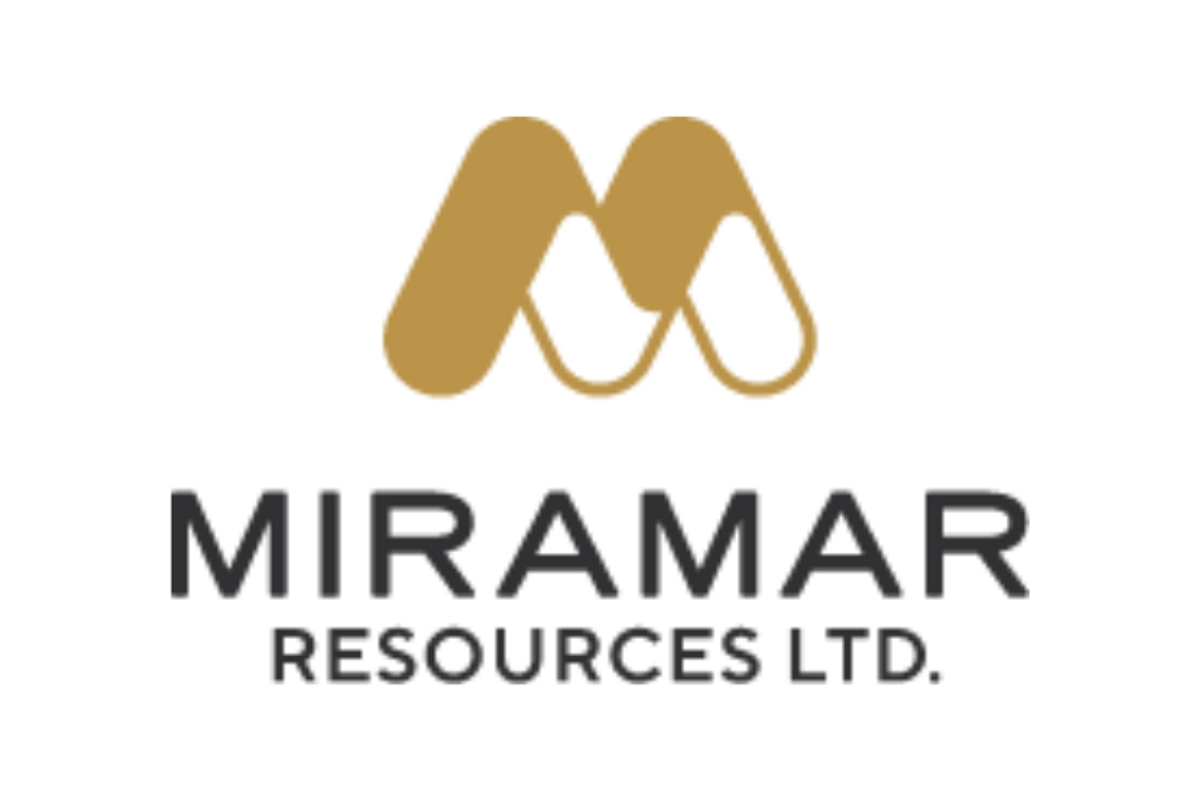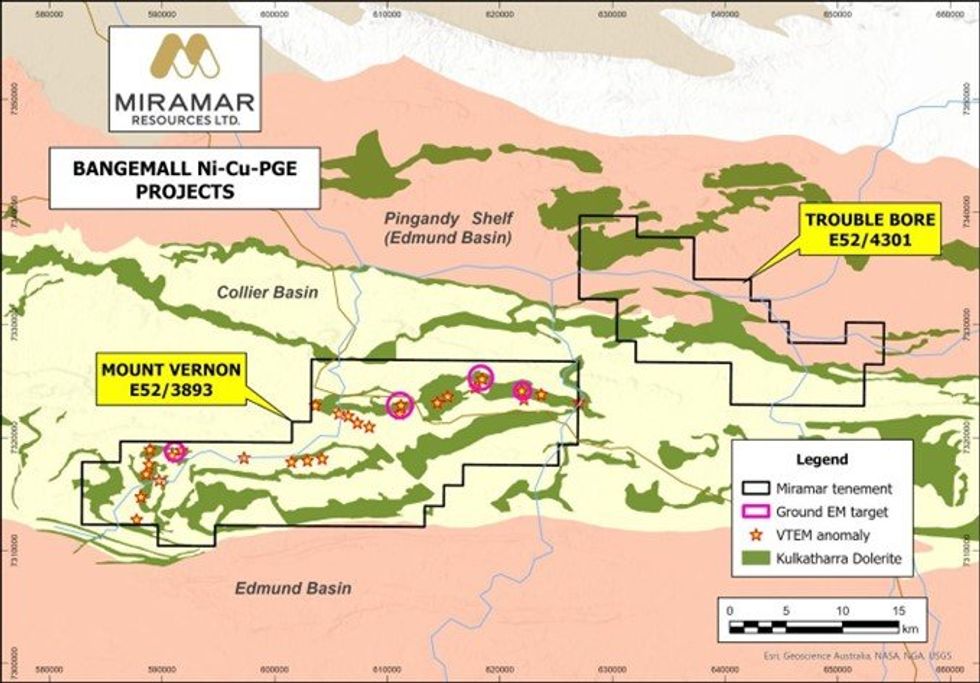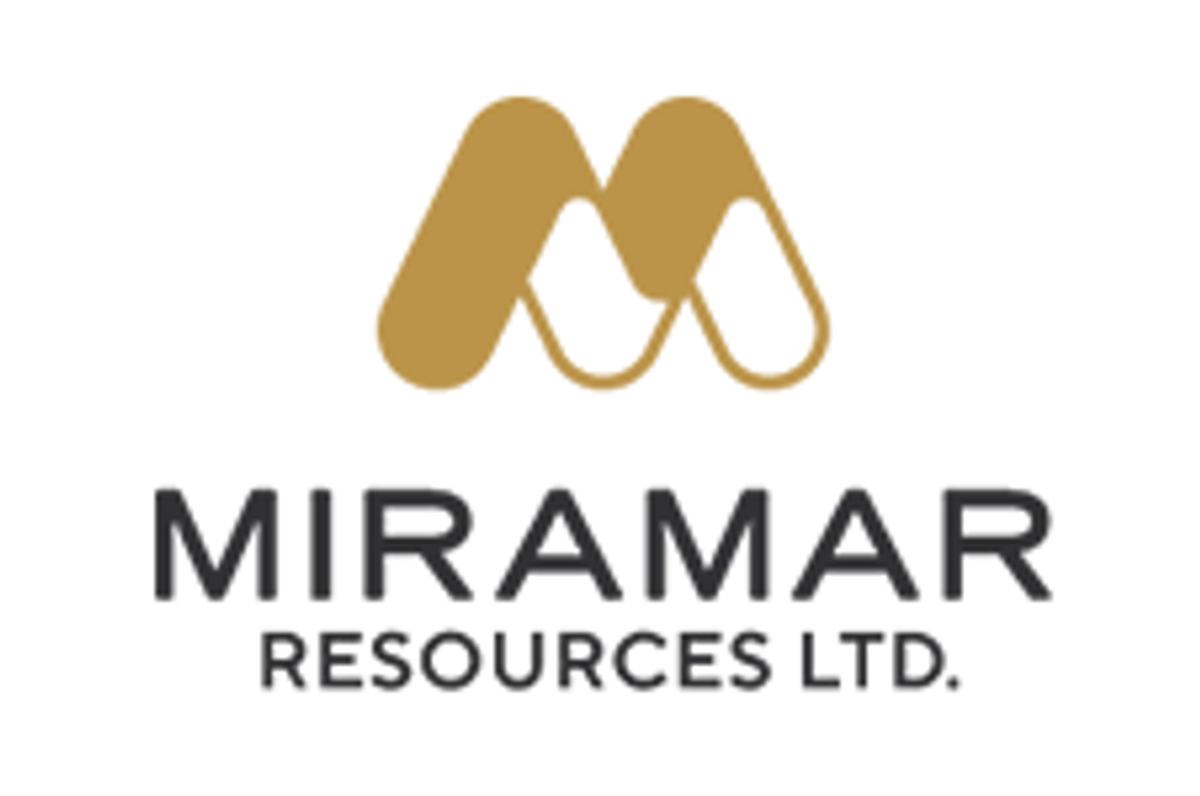
- NORTH AMERICA EDITIONAustraliaNorth AmericaWorld
January 01, 2024
Miramar Resources Limited (ASX:M2R, “Miramar” or “the Company”) is pleased to advise that it has expanded its 100%-owned Bangemall Project in the Gascoyne Region of WA with the recent grant of Exploration Licence E52/4301, adjacent to the high-priority Mount Vernon Ni-Cu-PGE Project (Figure 1).
- New Exploration Licence granted adjacent to Mount Vernon Project
- Historic EM data highlights multiple anomalies and potential feeder dykes
- Ground EM and RC drilling planned for high-priority Mount Vernon targets
Miramar has a substantial landholding in the Bangemall region and believes there is potential for nickel (Ni), copper (Cu) and platinum group element (PGE) mineralisation related to Kulkatharra Dolerite sills, part of the Warakurna Large Igenous Province and the same age as the Nebo and Babel Ni-Cu deposits.
The new “Trouble Bore” Project contains a number of these dolerite sills, and potential feeder dykes, intruding into sediments of the Collier Basin but has never been effectively explored for Ni-Cu-PGE’s.
Miramar’s Executive Chairman, Mr Allan Kelly, said the Company was aiming to show “proof of concept” at Bangemall through the discovery of Ni-Cu-PGE sulphides, either in outcrop and/or through drilling.
“If we are successful at Mount Vernon, it opens up the entire Bangemall region as a new nickel province, one in which we have built a commanding land position,” he said.

Trouble Bore
Exploration Licence E52/4301 (“Trouble Bore”) is located mostly within the Collier Basin and straddles the contact with the older Edmund Basin sediments within the Pingandy Shelf (Figure 1).
Across the southern two thirds of the tenement, the local geology is dominated by Kulkatharra Dolerite sills which intrude into sediments of the Collier Basin (Figure 2). The northwestern portion of the tenement is underlain by sediments of the Edmund Basin, also intruded by a dolerite sill.
Previous exploration is limited and sporadic and focussed mainly on exploration for sediment-hosted copper, lead and zinc during the 1990’s and early 2000’s. More recent exploration since 2009 focussed on the search for channel iron deposits (CID) by Rio Tinto Exploration in the period 2012-2014.
Rio Tinto flew a SkyTEM electromagnetic survey in 2013, with N-S survey lines and a relatively broad line spacing of 1000m, and subsequently drilled three RC holes within the area now covered by E52/4301.
The RC drilling failed to intersect CID mineralisation and Rio Tinto subsequently surrendered the tenements (WAMEX reports a100526, a104395 and a106023).
The SkyTEM data highlights EM anomalies coincident with the EW-trending sub-horizontal dolerite sills as well as two N-S trending anomalies which may represent sub-vertical feeder dykes linking the sills.
Feeder dykes are an important component of the “plumbing systems” associated with Ni-Cu-PGE deposits, as shown in Figure 3.
There is minimal reported surface geochemical data across the Project.
Click here for the full ASX Release
This article includes content from Miramar Resources Limited, licensed for the purpose of publishing on Investing News Australia. This article does not constitute financial product advice. It is your responsibility to perform proper due diligence before acting upon any information provided here. Please refer to our full disclaimer here.
copper stocksasx:m2rresource stocksasx stocksgold explorationgold stocksnickel stockscopper investingcopper explorationnickel exploration
M2R:AU
The Conversation (0)
06 February 2024
Miramar Resources
Aiming to create shareholder value through the discovery of world-class mineral deposits
Aiming to create shareholder value through the discovery of world-class mineral deposits Keep Reading...
31 December 2025
Surge in Copper Demand Re-energises Cobar Basin’s Underexplored Resource Potential
The Cobar Basin in Central New South Wales, Australia, may be emerging as a key focus for investors positioning for the next wave of copper supply. With a looming global shortage of the red metal and long-term demand being driven by electrification and decarbonisation, savvy investors are... Keep Reading...
29 December 2025
Nine Mile Metals Announces Certified High-Grade Assay Results up to 15.00% Copper from the Wedge Project, Bathurst, New Brunswick
Nine Mile Metals LTD. (CSE: NINE,OTC:VMSXF) (OTC Pink: VMSXF) (FSE: KQ9) (the "Company" or "Nine Mile") is pleased to announce Certified Assay results for volcanogenic massive sulphide (VMS) mineralization collected from the pre-drill area on the Wedge VMS Project, in the world-famous Bathurst... Keep Reading...
22 December 2025
Nine Mile Metals Announces Completion of DDH WD-25-02B and Continues to Confirm Zones of Copper Rich VMS with 66 Meters of Mineralization at the Wedge Project
Nine Mile Metals LTD. (CSE: NINE,OTC:VMSXF) (OTC Pink: VMSXF) (FSE: KQ9) (the "Company" or "Nine Mile") is pleased to announce that the 3rd drill hole in its Wedge Western Extension Drill Program (DDH-WD-25-02B) has been completed.DDH WD-25-02B was collared approximately 60 meters northwest of... Keep Reading...
19 December 2025
Top 5 Canadian Mining Stocks This Week: Pacific Empire Metals Gains 200 Percent on Drill Results
Welcome to the Investing News Network's weekly look at the best-performing Canadian mining stocks on the TSX, TSXV and CSE, starting with a round-up of Canadian and US news impacting the resource sector.Statistics Canada released November’s consumer price index (CPI) data on Monday (December... Keep Reading...
17 December 2025
Nine Mile Metals Announces Certified High-Grade Assay Results up to 15.21% Copper from the Wedge Project, Bathurst, New Brunswick
Nine Mile Metals LTD. (CSE: NINE,OTC:VMSXF) (OTC Pink: VMSXF) (FSE: KQ9) (the "Company" or "Nine Mile") is pleased to announce Certified Assay results for volcanogenic massive sulphide (VMS) mineralization collected from the pre-drill area on the Wedge VMS Project, in the world-famous Bathurst... Keep Reading...
Latest News
Interactive Chart
Latest Press Releases
Westport Announces Board of Directors Update
02 January
Related News
TOP STOCKS
American Battery4.030.24
Aion Therapeutic0.10-0.01
Cybin Corp2.140.00




